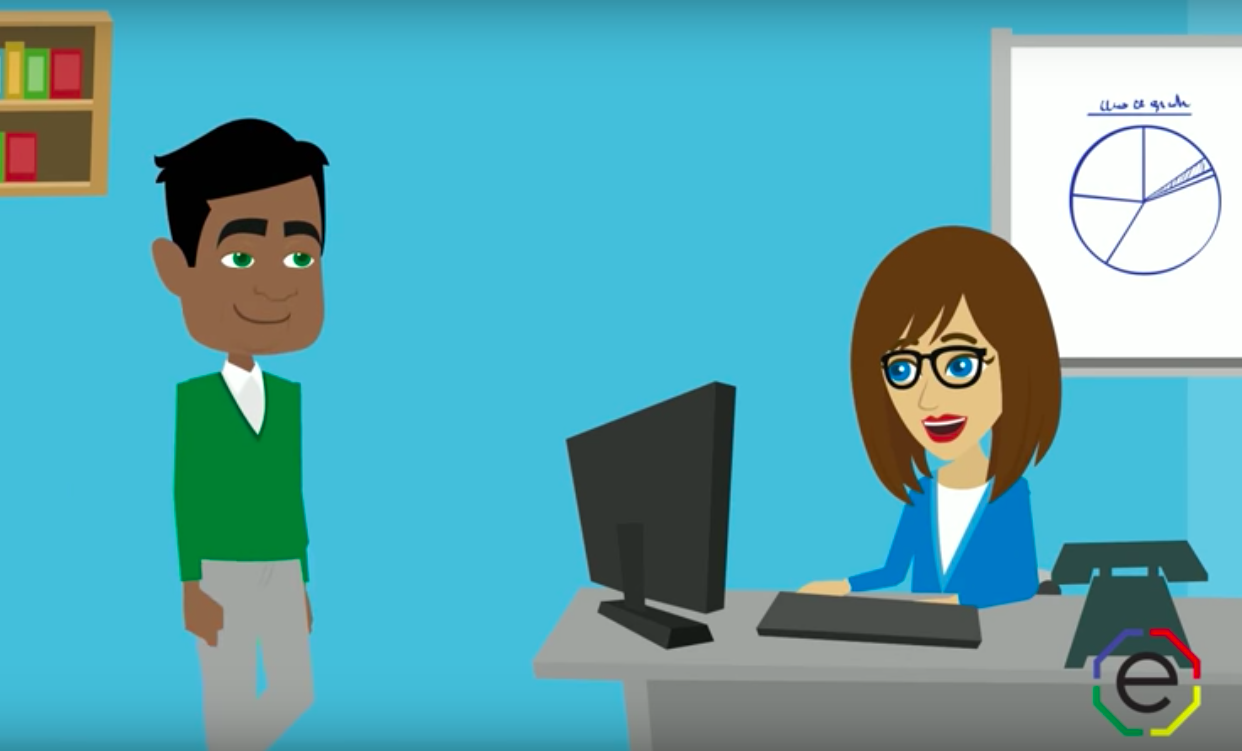We seek out our C-style co-workers when we need a problem-solver; yet their nit-pickiness can irritate us. Understanding your C-style colleagues can help you to work better with them.
Your C-style co-worker: Carol
We all know or work with a C-style like Carol. She’s quieter and more reserved than many of your co-workers. You would describe her as matter-of-fact, analytical, meticulous, and compliant. Sometimes you’d even describe her as a perfectionist, timid, and withdrawn.

Carol’s office space and preferred environment
Carol can usually be found in her office. You don’t usually see her eating lunch at the lunch room tables or lingering in the hallway chatting. Her preferred place is where she feels comfortable and can avoid the office chaos. She also avoids getting stopped to talk about inconsequential or non-work related topics. Her office is organized and designed to house her data. Carol, despite living in the age of technology, has a full file cabinet and shelving to keep files organized and keep all of her documents accessible. She wants to get as much information from every possible source.
Carol likes to have a private space since she prefers to work alone. In fact, she can become so focused on a specific task she may not come out of her office for a long time. She works quietly and diligently, minimizing any interruptions. You notice her door is often closed. In fact, you get the sense you’re disturbing her when you call her to ask a question or pop in for a chat.
Identifying Carol in your office
Carol is quieter and more reserved than your other colleagues, so it’s been harder getting to know her. She prefers to stay away from the chaotic, social areas and can most often be found in her office. Carol rarely speaks up in meetings, but she will when she’s able to show her expertise. You can get her talking about topics she’s knowledgeable about, especially when it’s just the two of you or in small groups.

Carol’s your team’s content expert and specialist. She takes a seemingly long time to understand the processes and products. She’s actually read all the emails and manuals that get passed around. The team often goes to her when they encounter a technical problem. For example, you’ll seek her out when you have trouble interpreting project data results or you don’t know how the new product works. Unfortunately, her technical explanations can go over your head or you wish she’d just get to the point already. You bring her documents when they need to be looked over with a fine tooth comb and you know that if you want it done correctly, ask Carol.
Carol’s not a quick decision maker. She’s gotten upset when you rush her or move too quickly. Don’t take it personally; she just wants to make sure it’s done right. She’s best at focusing on one task at a time so try not to overwhelm her. You find it hard to convince or sway her unless you use expert or hard facts. Carol has a tendency to over-analyze; to her there’s no such thing as “too much information.” When you question her work or results she can get defensive or appear crushed. She will go back, check and double check everything. Her goal is to make sure everything is perfect which can be great or irritating.
How Carol compares to other co-workers
 Carol is the realistic one and helps keep the team grounded; whereas I-style Ian tends to be excitable and sometimes disorganized. She’s quiet while he’s talkative.
Carol is the realistic one and helps keep the team grounded; whereas I-style Ian tends to be excitable and sometimes disorganized. She’s quiet while he’s talkative.
S-style Sam seems similar to Carol’s style since both are more reserved and quieter. The major difference between Carol and Sam is Sam’s tendency to focus on the person and the person’s feelings, whereas, Carol, normally focus’ on the data and tasks.
Carol and D-style Diana are both task oriented and both want to control the process. However, Diana wants it done now and Carol wants to take the time to do it correctly. Carol wants clear predictable goals, whereas Diana keeps creating new and sometimes risky ones.
Carol’s strengths and when she over uses them
Carol can get stressed when her team is disorganized and moving at a fast pace. She may retreat into her office and shut the door.
She seems to follow the mantra, “there’s no such thing as too much data,” but that’s gotten her into trouble. You’ve seen her go into “analysis paralysis”. She can’t seem to accept “good enough” because “perfect” is only acceptable. You’ve gotten impatient waiting for her to finish up. You know it’s sometimes better to wrap it up and a few mistakes are just part of the process or can be addressed later. Carol can even end up not making a decision. You wish she’d take a step back and see the big picture. In fact, you’ve tried to convince her more information doesn’t always improve the quality of the decision or a quick decision can be better than waiting for a perfect one.
You can also be frustrated by Carol’s refusal to be flexible. Carol sees her way as the only “right way” and she will not budge. She irritates you by pointing out nit-picky mistakes. Does it have to be perfect every time? She’s also the first to beat herself up when she’s made a mistake. There’s no one harder on Carol than herself. She can’t let it go even when everyone else is comfortable moving on.
How Carol prefers to communicate
 Carol’s communication style is formal and diplomatic. She speaks slowly, without a lot of inflection in her voice. You find it challenging to to hear her opinions or talk with her about non-work topics. She may ask questions to help her understand. Her feedback tends to be economical. You’re not sure if you’ve gotten positive feedback, when she’s answers, “that’s good.”
Carol’s communication style is formal and diplomatic. She speaks slowly, without a lot of inflection in her voice. You find it challenging to to hear her opinions or talk with her about non-work topics. She may ask questions to help her understand. Her feedback tends to be economical. You’re not sure if you’ve gotten positive feedback, when she’s answers, “that’s good.”
She uses a lot of facts and details and doesn’t express disagreeing views unless she sees a chance to correct. Even then she may not confront you face-to-face, but prefers an email. If there’s going to be a face-to-face or group meeting, she wants to know what to expect.
Carol wants you to explain instructions clearly, and preferably in writing. In fact, a majority of your communication with her are emails. Your inbox “dings” to announce the arrival of an email from Carol. Did you take a deep breath before clicking on it? You already know from experience it’s going to be a long one or she’s requesting more information.
Understanding Carol’s perspective and appreciating her differences
 Carol focuses on doing things correctly the first time and every time. She is the team’s resident specialist who we look for when we need help problem-solving and designing a solution. She thrives on systems and protocols when some of us tend to avoid. Carol loves protocol and systems. In fact, she volunteered to set up a protocol for the lunch room refrigerator. Diana and Ian often push our team to think outside the box, but Carol helps us to comply with our company’s standards.
Carol focuses on doing things correctly the first time and every time. She is the team’s resident specialist who we look for when we need help problem-solving and designing a solution. She thrives on systems and protocols when some of us tend to avoid. Carol loves protocol and systems. In fact, she volunteered to set up a protocol for the lunch room refrigerator. Diana and Ian often push our team to think outside the box, but Carol helps us to comply with our company’s standards.
If we understand Carol’s approach to things, we are able to better adjust our style to interact with her more effectively. For example, the next time we send her an email, make sure it is answers her questions carefully. There is a likelihood she will respond more positively. The team looks to her to make sure everything works the way it should. She is able to evaluate different alternatives by patiently considering all angles.
Consider the things Carol does in the team. She’s thorough and takes pride in her work. Carol actually makes our job easier because she is comfortable assuming roles and responsibilities that we may not be as comfortable with. Take a step back and appreciate what Carol brings to your team that makes it more successful.
How we can work better with Carol
 Plan ahead and be prepared. Be diplomatic and focus more on details and facts. Answer her questions slowly and give her time to get her work done. You can help Carol take a step back and see the big picture and understand quicker decisions are sometimes more effective than trying to get to the perfect one.
Plan ahead and be prepared. Be diplomatic and focus more on details and facts. Answer her questions slowly and give her time to get her work done. You can help Carol take a step back and see the big picture and understand quicker decisions are sometimes more effective than trying to get to the perfect one.
Remember there is no DISC style that is better or worse. We all have similarities and we all have differences in our styles. Each one of us brings our own strengths and areas of development to our team. We never want be stereotyped or pigeonholed into our DISC style; we are more complex than just our DISC style.
Think of your own Carol. Now that you have a better understanding of her DISC style are there any simple adjustments you could make (e.g., send her agenda first, avoid the chatter, etc) the next time you interact with her ?

